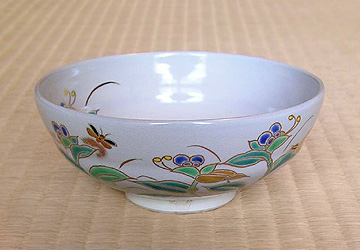|
||
 |
||
| @ |
 |
| @ |
| @ |
@
(C)2001 Japanese Architecture and Art Net Users System.@No reproduction or republication without written permission.
fÚÌeLXgEÊ^ECXgÈÇASÄÌRec̳f¡»E]ÚğֶܷB
|
||||||
| @ | ||||||
| kyouyaki@Ä | ||||||
| KEY WORD :@art history / crafts | ||||||
| @ | ||||||
| Kyoto ware. General name of the ceramic wares of Kyoto (except *rakuyaki yÄ), beginning in the Momoyama period and often decorated with polychrome enamels. In the early 17c, a potter (or potters) from Seto £Ë moved to Awataguchi ¾cû and made copies of Seto ware *setoyaki £ËÄ in the *karamono ¨ (Chinese) and Kourai í (Korean), sabi-e çöG (rusty painting), and *sometsuke õt (blue-and-white china) styles. Between 1655 and 58, Nonomura Ninsei ìXºm´ perfected *iro-e FG techniques by employing aspects of oshikoujiyaki ¬HÄ together with the styles of Chinese kouchiyaki ğæäÄ and *shippou µó (cloisonne). Ninsei's luxurious tea-related wares, made at his kiln in Omuro äº near Ninnaji ma, were patronized by aristocrats and samurai , establishing a strong patron base for kyouyaki. Ogata Kenzan ö`£R (1663-1743) developed these traditions at the end of the Genroku ³\ era (1688-1704). Later most kyouyaki kilns moved to the Gojouzaka Üğâ area below Kiyomizudera ´ . In the Bunka ¶» and Bunsei ¶ eras (1804-30), Okuda Eisen cnì (1753-1811) and Aoki Mokubee ÂØØÄ (1767-1833) made porcelains. With the fashion for green tea sencha ÷, Chinese-style sometsuke and iro-e jiki FG¥í (multi colored porcelains) dominated with these iro-e jiki commonly called *kiyomizuyaki ´ Ä. At this time such great potters as Takahashi (Ninnami) Douhachi ´(m¢í)¹ª (1783-1855) and Ogata Shuuhei ö`ü½ (1788-1830) gained fame. Because much kyouyaki derives from foreign models, the ware exhibits a wide range of techniques: pieces may be wheel thrown, formed by hand or using molds: Stamp inka óÔ, comb kushime ùÚ, inlay *zougan ÛÆ, and slip trailing itchin Cb` are common design techniques; and dipping, dripping, trailing, painting and spraying are used to apply the primarily mineral glazes. | ||||||
| @ | ||||||
|
||||||
@ |
||||||
| REFERENCES: | ||||||
| @ | ||||||
| EXTERNAL LINKS: | ||||||
| @@ | ||||||
| NOTES: | ||||||
| @ | ||||||
(C)2001 Japanese Architecture and Art Net Users System.@No reproduction or republication without written permission. fÚÌeLXgEÊ^ECXgÈÇASÄÌRec̳f¡»E]ÚğֶܷB |
||||||
| @ |